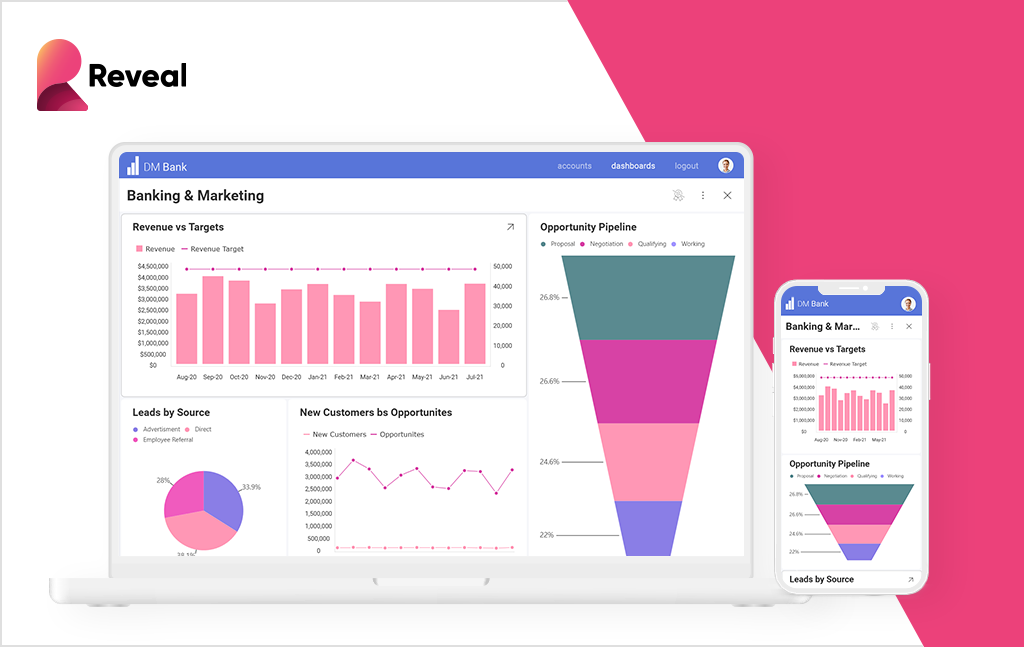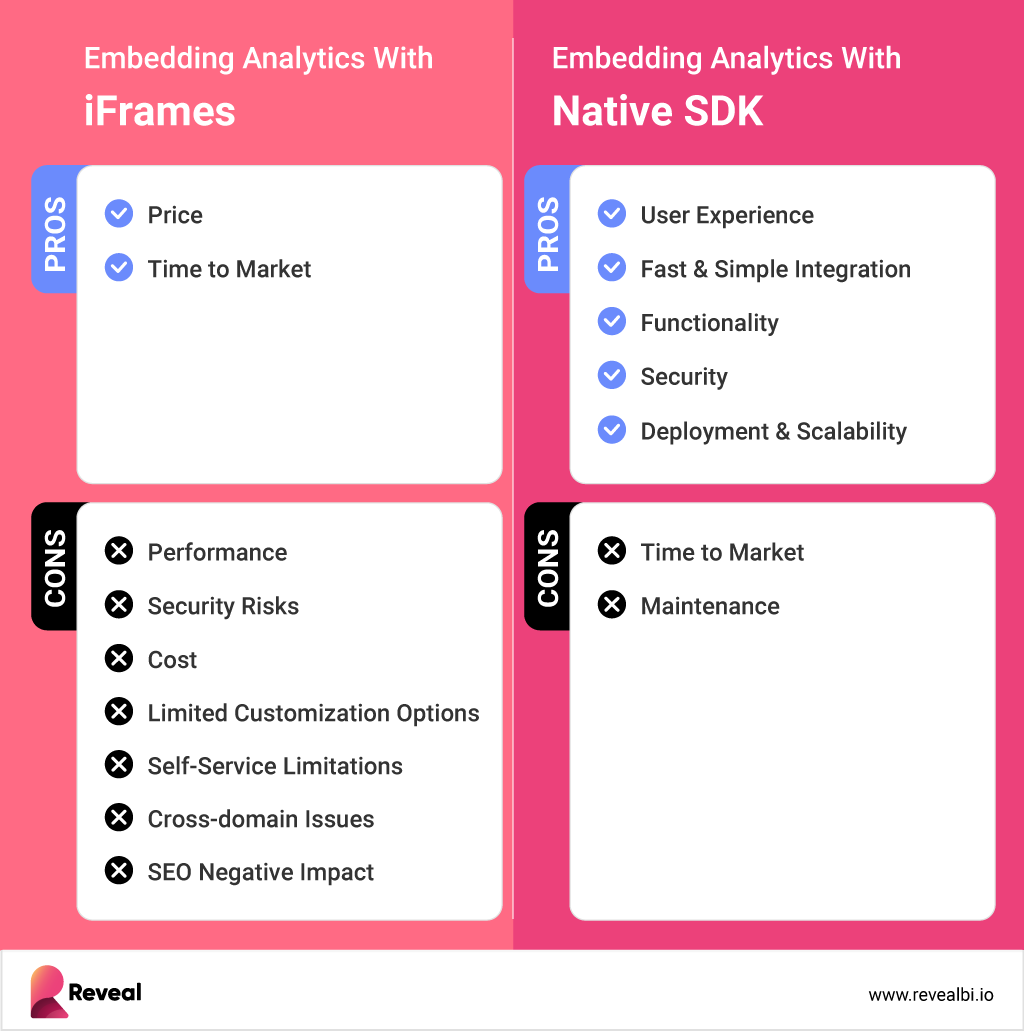
Scriptly Helps Pharmacies Identify Trends in Real Time with Reveal
In this guide, we’ll cover the key 2025 requirements for selecting an embedded analytics platform, how it benefits product analytics, and the current available implementation methods.
Data-driven companies have a hidden advantage!
They’ve consistently outperformed their counterparts, reporting significantly higher metrics across operational efficiency (81% vs. 58%), revenue growth (77% vs. 61%), and employee satisfaction (68% vs. 39%). How is this possible?
This advantage stems from a simple fact: access to actionable insights empowers smarter, faster decision-making.
Leaders across industries are recognizing this and moving fast to prioritize data democratization—ensuring data is accessible to everyone—as a foundation of their SaaS development. According to a recent survey, 91% of business leaders agree that democratizing access to data and analytics is crucial to their software’s success.
Embedded analytics tools are pivotal in achieving this goal, seamlessly integrating data insights into everyday workflows. Whether you’re building internal tools or customer-facing products, embedded business intelligence (BI) brings the power of data for all users.
In this detailed guide, we’ll cover the embedded analytics requirements for selecting an embedded analytics tool, its transformative benefits for product analytics, and the available implementation methods.
Embedded analytics delivers real-time data insights directly within the applications your teams or customers use every day. By integrating analytics into existing workflows, users can make data-driven decisions faster—without relying on separate tools or external teams—saving time and driving productivity. Traditionally, companies have tackled analytics through two main approaches:
Embedded analytics solves these pain points by providing insights directly within your application, allowing sales teams to track performance metrics in their CRM and operations teams to monitor workflows through embedded dashboards. This removes the hassle of switching apps or needing specialized training, letting users focus on decisions—not data gathering.

Embedded analytics integrates insights directly into your application’s workflows, giving users real-time data exactly where they need it. When users interact with embedded reports or dashboards, the platform retrieves data from connected sources, processes it into actionable insights, and visualizes it seamlessly—all without interrupting their workflow. Behind the scenes, this process includes:
This seamless integration ensures users get real-time insights in the context of their tasks, streamlining decision-making and improving the overall experience.
Organizations and ISVs looking to embed analytics into their software products must prioritize certain key requirements when comparing embedded analytics tools
Users need real-time insights to make proactive decisions. Embedded analytics delivers up-to-date data, helping users monitor performance and respond quickly to market changes. This reduces delays, breaks down data silos, and empowers swift action to minimize risks and seize opportunities.
Both technical and non-technical users should be able to tailor dashboards and reports effortlessly. Look for platforms with drag-and-drop interfaces for easy modifications, while also supporting advanced customizations for technical teams. This dual focus ensures all users can derive value, regardless of their expertise.
An embedded analytics solution should blend seamlessly with your product, feeling like a natural part of it rather than an add-on. Solutions like Reveal achieve this with a fully branded, SDK-first approach, enabling smooth integration into your applications. This methodology provides the flexibility to create highly customizable experiences that match your product’s vision and deliver direct value to your users.
Scalability shouldn’t mean hidden costs! Choose a platform with predictable, fixed pricing to plan for growth without worrying about unexpected charges as your usage increases or paying per user. Reveal’s transparent pricing lets you focus on delivering value to your users while keeping costs predictable.
As your business grows, so will your data needs. Ensure your chosen platform can handle increased workloads without compromising performance, delivering real-time analytics integration and maintaining reliability even as data volumes expand. The architecture should be designed to scale seamlessly, ensuring your users experience consistent performance regardless of operational demands.
With 29% of cybersecurity breaches involving third-party vendors, security must be a top priority.
Per IBM, each data breach costs about $4.88 million, underscoring the importance of prioritizing security and compliance as an integral requirement for choosing an embedded analytics platform.
Adoption hinges on ease of use and ongoing support. Choosing the right embedded analytics platform means prioritizing a solution that guides you every step of the way:
Future-proof your investment by selecting a platform with advanced features like AI-powered insights, machine learning, predictive analytics, and real-time monitoring. Even if not immediately needed, these capabilities will support your evolving requirements.
When embedding analytics into your application, there are two primary approaches to consider:
While iFrames might suit basic use cases, SDKs and APIs are the gold standard for software companies seeking advanced functionality, seamless integration, and full control over the user experience. SDKs allow for tighter integration with your application’s workflows and UI, enabling you to maintain their product’s unique branding and functionality without compromise. This approach also provides more significant opportunities for innovation, allowing businesses to adapt their analytics capabilities as their needs evolve.
Reveal is a leading SDK-based embedded analytics platform, offering unmatched flexibility and seamless integration. With Reveal, you can:
Summary: By choosing Reveal, you’re opting for an SDK-first solution that meets your users’ needs today while ensuring effortless scalability for the future.

For an in-depth overview of these methods, please read our “Embedded Analytics SDK vs. iframes: Which is the Better Integration Option?” guide.
Embedding analytics into product analytics enhances your product in several ways, including the following methods:
In 2025, the right embedded analytics platform will unlock your data’s full potential. Reveal’s embedding-first approach ticks all the boxes, offering real-time insights, seamless integration, advanced customization, and robust security. Discover how Reveal can transform your products and empower your users.
Book your personal demo today to find out how Reveal can help!